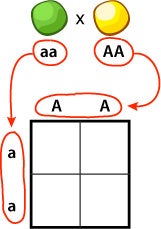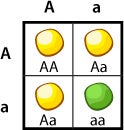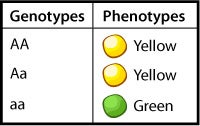Baby Butterfly Punnett Squares Pictures Basic Parent Butterfly
Punnett Squares
Punnett squares are a useful tool for predicting what the offspring will wait like when mating plants or animals. Reginald Crundall Punnett, a mathematician, came up with these in 1905, long after Mendel's experiments. Permit's take a await at how Punnet squares piece of work using the yellowish and green peas example from Mendel'south garden experiments.

For every gene, dissimilar versions chosen alleles be. Alleles control things like pea color or the presence of dimples on your face. Children inherit 2 alleles for each gene from their parents, ane from the mother and 1 from the father.
The genotype refers to which ii alleles an organism has. Sometimes both alleles are the aforementioned and sometimes they are different. The phenotype refers to the visible trait that results from the combination of alleles that are present.
Parent Generation
Mendel began his experiments with true breeding strains, meaning plants that accept offspring of only 1 phenotype when mated. In truthful convenance strains, both alleles are the aforementioned for a gene. Since in that location is simply ane kind of allele present, mating two plants from the aforementioned strain will produce offspring that take the same phenotype and genotype every bit their parents. Plants or animals with two identical alleles for a gene are said to be homozygous.
Commencement Generation
Mendel commencement crossed two unlike true breeding strains together, ane that produced yellowish peas and one that produced green peas. We'll use letters to represent alleles. Capital "A" will correspond the yellow pea allele and lowercase "a" will represent the green pea allele.
The yellowish pea phenotype has a genotype of AA.
The green pea phenotype has a genotype of aa.

When Mendel looked at the results of this mating, he saw that all of the offspring had xanthous seeds. How did this happen? If 1 of the parent plants had dark-green peas, why didn't a single one of the children plants have green peas? We tin respond these questions and understand what's happening to the alleles in this crossing with the help of a Punnet Square.
Brainstorm by writing the parents' genotypes forth the top and side of the Punnet square.

Next, fill in each cell with 2 alleles, one from the parent along the pinnacle and 1 from the parent along the side. The letters in the eye show you lot all possible combinations of alleles that tin happen from mating these two genotypes.

In this case, all offspring have the aforementioned genotype and phenotype. The order of the messages doesn't brand a divergence in the phenotype (aA is the same as Aa) simply the capital letter letter is usually written before the lowercase one. These offspring are said to be heterozygous, significant that they have two different alleles for pea colour.
Despite the fact that both alleles are present in the offspring, the traits did not blend together to result in yellowish-greenish peas. Instead, but one phenotype was visible and all peas were yellowish. Because of this, the yellow pea phenotype is said to be ascendant, meaning that it is visible in the heterozygous private.

Second Generation
For the second generation, Mendel mated the heterozygous offspring from the outset generation together.

When Mendel looked at the offspring from this mating, he noticed that 1/4 of the children plants had green seeds. Why did this happen? How was it possible for some of the offspring to have dark-green seeds when both of the parent plants had xanthous seeds? Let's once once again employ a Punnet square to answer these questions and sympathise what'due south happening to the alleles in this crossing.

By looking at the Punnett foursquare, we see that there are three possible genotypes that could result from this crossing: AA, Aa, aa. The genotypes AA and Aa will issue in the xanthous pea phenotype because A is dominant. Only aa will produce the green pea phenotype.

Now we see how it was possible for the green pea phenotype to skip a generation. The green pea allele was present in the F1 generation, but the phenotype was hidden by the yellowish pea allele. The green pea phenotype is said to be recessive, pregnant that it is only visible in the homozygous individual when the yellow allele is not present.
Probability
In the F2 generation, simply 1 of the 4 boxes produced green peas. In other words, 25% of the offspring had greenish peas. This number tells you the probability, or likelihood, that an offspring will produce green or xanthous peas.
We tin use the probability to predict how many offspring are likely to take certain phenotype when mating plants or animals with different traits. Just take the probability of a phenotype and multiply it by the full number of offspring. Let'due south imagine in that location were 160 total offspring in Mendel's F2 generation. How many peas are likely to be green?
25% green peas 10 160 total offspring = 40 greenish pea offspring
(Don't forget that 25% = 0.25)
Attempt It Yourself!
To learn more about Mendelian Genetics and the different means that genes determine phenotype, effort solving these Punnett Square puzzles from the Biology Project.
Additional images from Wikimedia. Pea motion-picture show by Bill Ebbesen.
Source: https://askabiologist.asu.edu/punnett-squares
0 Response to "Baby Butterfly Punnett Squares Pictures Basic Parent Butterfly"
Post a Comment